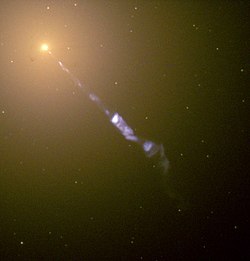Blazar
A blazar is a very compact quasar (quasi-stellar radio source). They have a presumed supermassive black hole at the center of an active, giant elliptical galaxy. Blazars are among the most energetic phenomena in the universe and are an important topic in astronomy.

Blazars are one of a group of active galaxies that host active galactic nuclei (AGN). An AGN is a region at the centre of a galaxy which has a much higher than normal luminosity over some or all of the electromagnetic spectrum.
The name "blazar" was originally coined in 1978 by astronomer Edward Spiegel. Blazars are AGN with a relativistic jet[1] which is pointing in the general direction of the Earth. We observe "down" the jet, or nearly so. Many blazars have apparent superluminal features[2] within the first few parsecs of their jets, probably due to relativistic shock fronts.[3][4]
The blazar at the centre of galaxy M87 is fuelled by a black hole with a mass of about three billion solar masses within ten light years of the galaxy centre.[4]
References
change- ↑ relativistic = moving at or close to the speed of light
- ↑ superluminal features = look like they move faster than light
- ↑ relativistic shock: shock velocity is close to the speed of light. Expected in gamma ray bursts, active galactic nucleus jets and in some types of supernova explosions.
- ↑ 4.0 4.1 Biretta, John (1999). "HUBBLE detects faster-than-light motion in galaxy M87". Baltimore, Maryland: Space Telecsope Science Institute.